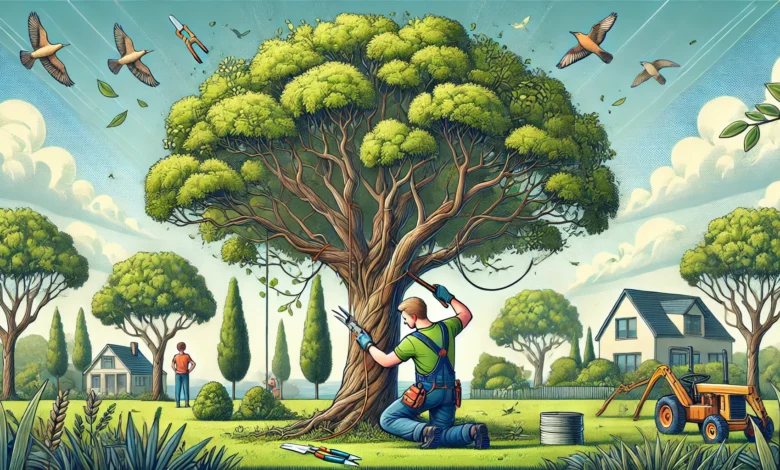The Art and Science of Tree Care: Cultivating Healthy Urban Environments

What Is Tree Care?
Tree care is a multifaceted discipline that involves a variety of practices aimed at nurturing healthy trees in both urban and rural landscapes. The methods span from careful planting procedures, which lay the groundwork for young trees, to advanced pruning techniques employed to maintain mature trees. These practices are essential for trees to grow vigorously and to adapt to changing environmental conditions.
Besides these traditional methods, tree care also involves innovative solutions tailored to maximize the benefits trees offer. Urban trees face many challenges, including air pollution and soil compaction. By understanding the comprehensive needs of trees, we can cultivate green spaces that thrive in urban settings. Moreover, the use of firewood Sussex County NJ demonstrates how communities can leverage sustainable practices by repurposing tree remnants into valuable resources.
Understanding the Importance of Tree Care
Trees are indispensable in creating healthier cities. They play a crucial role in improving air quality by absorbing pollutants and releasing oxygen. Trees also mitigate urban heat through shading and evapotranspiration, leading to cooler, more comfortable environments that benefit public health. Furthermore, urban trees enhance aesthetic appeal, reduce noise pollution, and support wildlife habitats, contributing to the overall quality of life for city dwellers.
Investing in systematic tree care practices is key to unlocking these benefits. Well-maintained trees not only contribute to environmental sustainability but also boost economic prosperity. Homes surrounded by mature trees often see increased property values and the strategic placement of shade trees can lower energy costs significantly. For an in-depth understanding of the ecological and economic benefits of trees, you can explore resources from the Arbor Day Foundation.
Basic Tree Care Tips for Homeowners
- Watering: One of the fundamental aspects of tree care is proper watering. Young trees require consistent moisture for root establishment, especially during dry periods. Ensure you water deeply and infrequently to encourage deep root growth, rather than shallow, frequent watering that can lead to surface roots.
- Mulching: Mulch is essential for conserving soil moisture, suppressing weeds, and enhancing soil quality. Apply a 2-4 inch layer of organic mulch over the root zone, taking care not to let it touch the trunk, which can lead to rot.
- Pruning: Pruning is crucial for removing dead or diseased branches, shaping growth, and increasing light penetration. It’s best done in late winter or early spring when trees are dormant and less prone to pest invasion.
Choosing the Right Tree for Urban Spaces
Selecting the right tree species for urban planting can foresee the success or failure of your landscaping efforts. Factors to think about include the mature size of the tree, soil conditions, available sunlight, and resistance to local pests and diseases. Trees that are particularly suited for urban conditions typically have a high tolerance to drought, pollution, and limited rooting space.
It’s also essential to think long-term about the tree’s compatibility with its environment to prevent future issues like interference with power lines or infrastructure. Valuable guidance on choosing tree species that thrive in various regions and conditions can be found at the Missouri Botanical Garden, which provides extensive resources for gardeners and urban planners alike.
When to Call Professional Tree Services
While basic tree care can often be managed by homeowners, certain situations call for expert intervention. Professional arborists are equipped to handle complex tree issues such as disease outbreaks, which require diagnostic skills and treatment plans; extensive pruning or cabling needed to ensure tree stability and safety; and safe tree removal when necessary.
In addition to their technical skills, arborists offer valuable advice on improving the long-term health of your trees through proper nutrition and preventive care. Recognizing when to engage a professional can prevent minor issues from developing into serious hazards, ensuring the safety and beauty of your property.
Latest Trends in Tree Care
The field of tree care continues to evolve with advancing technology and growing awareness of sustainable practices. Drones are increasingly used for aerial tree assessments, providing detailed imagery and data without disturbing the landscape or trees being surveyed. This innovation allows for more comprehensive monitoring of tree health and structure.
Additionally, biochar—a form of charcoal used to enrich soil fertility—is gaining traction as a method for improving urban soil conditions. By enhancing water retention and nutrient availability, biochar supports robust tree growth and overall ecosystem vitality.
Additional Resources and Tools
As the importance of tree care becomes more widely recognized, countless online platforms are offering detailed guides, webinars, and community forums to keep enthusiasts informed. Engaging with these resources helps individuals and communities implement effective tree care strategies, ensuring a greener and healthier urban future. Whether you’re a seasoned arborist or a curious homeowner, there’s always more to learn and explore in the dynamic field of tree care.




